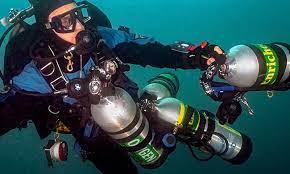The typical lifespan of an aluminum scuba tank is a function of proper care rather than a fixed expiration date; key factors include the hydrostatic test every 5 years to check for strength, internal corrosion from moisture, external damage from drops, the number of fills, proper rinsing after saltwater use, and storage conditions, with many tanks lasting over 20 years and thousands of dives with excellent maintenance.
Regular Hydrostatic Testing Matters
A tank fails the test if it does not return to within a 102% tolerance limit of its original, pre-pressurized volume.
-
The standard test pressure for an common 80-cubic-foot aluminum tank, which has a normal working pressure of 3,000 pounds per square inch (PSI), is pressurized up to 5,000 PSI or 1.66 times its service pressure during the test.
-
The entire testing process, including a visual interior inspection, typically takes a certified tester about 30 to 45 minutes per tank.
-
The average cost for a hydrostatic test at your local dive shop ranges from 75. This is a small investment compared to the cost of a new tank (over $350) and more importantly, your safety.
-
After a tank passes, the test date is stamped permanently into the tank’s shoulder near its other manufacturing codes.
-
Neglecting this 5-year test doesn't just risk a fine; it risks your life. An aging, untested tank can suffer from a catastrophic failure—a rapid, explosive rupture.
Preventing Internal Corrosion Build-up
For instance, air with a relative humidity of 80% introduces roughly 8 times more water vapor per volume than air at 20% humidity, creating a perfect storm for corrosion.
This is why the annual Visual Inspection (VI) is arguably more important than the 5-year hydrotest for catching problems early. A certified inspector uses a bright light and borescope to examine 100% of the interior surface, measuring the depth, diameter, and distribution of any pits. The pass/fail criteria are extremely strict: a single pit measuring deeper than 0.005 inches (0.127 mm) can be enough to permanently condemn the tank. Widespread, peppering pitting covering more than 25% of the internal surface area will also lead to a failure. The financial cost of neglect is total: a failed tank is unsalvageable, resulting in an immediate 100% loss of your 400 investment.
|
Factor & Mechanism |
Quantifiable Data & Impact |
Prevention Standard |
|---|---|---|
|
Humid Compressed Air |
Air from a poorly maintained compressor at >70% RH introduces ~3-5 grams of water vapor per full fill. This is the primary catalyst. |
Only use stations with certified filters that output air at <40% relative humidity. |
|
Residual Water Pooling |
As little as 5-10 mL (1-2 tsp) of water left inside can coat the entire surface area of ~500 in², initiating pitting within 3-6 months of storage. |
After rinsing, drain for ≥2 minutes and store vertically to ensure complete evacuation. |
|
Saltwater Crystallization |
Salt crystals are highly hygroscopic and corrosive, increasing the pit growth rate by a factor of 3-5x compared to freshwater exposure. |
Perform an immediate internal freshwater rinse after every saltwater dive, without exception. |
|
Visual Inspection (VI) |
Annual inspection is mandatory. Average cost: 25. Measures pit depth (max 0.127mm) and density (<25% coverage). |
A single violation of either depth or density threshold results in failure. |
|
Storage Pressure |
Storing a tank at 0 PSI (empty) allows humid ambient air (e.g., 80°F at 60% RH) to be sucked in, where it condenses on the cooler walls. |
Always store with 200-500 PSI of clean, dry air to create a positive pressure moisture barrier. |
The ultimate prevention strategy is simple and takes less than 5 minutes. After your final dive of the day, pour approximately 1 liter of fresh water into the tank, replace the valve, and shake vigorously for 60 seconds. Drain it completely and store it in a cool, dry place with 200-500 PSI of pressure inside. This minimal routine, performed with 100% consistency, is the single most effective action you can take to ensure your tank remains in service for its full potential 20-year lifespan.

Avoiding External Damage and Dents
The aluminum alloys used, primarily 6351-T6 or 6061-T6, have a tensile strength around 31,000 to 35,000 PSI, but their yield strength is significantly lower, at roughly 24,000 PSI. This means the metal can bend or deform under pressure much more easily than you'd think. The real danger starts when a dent is deeper than 10% of the tank’s diameter or located in high-stress areas like the valve, boot, or base.
A single dent deeper than 1/4 inch (6.35 mm) on a standard 80 cubic foot tank (approximately 7.25 inches in diameter) is considered severe. Industry data shows that tanks with dents exceeding 8 mm in depth have a 40-60% higher chance of failing under pressure, even if they visually appear intact. Many reputable fill stations enforce stricter limits and will refuse to fill tanks with dents deeper than 4 mm (0.16 inches) if those dents are in sensitive areas.
Dents often occur from seemingly minor incidents—dropping the tank from as little as 3-4 feet onto a hard surface, knocking it over, or bumping it against sharp edges during transport or storage. A compromised tank can rupture under pressure, releasing its stored 3,000 PSI in an instant—a force equivalent to over 1,000 pounds of impact.
How Fill Cycles Affect Longevity
Every fill cycle subjects the cylinder to 3,000 PSI of pressure, causing the aluminum alloy to expand minutely.While a well-maintained tank can handle thousands of fills, two factors dramatically accelerate wear: fill speed and air temperature. A rapid fill (under 5 minutes) generates intense heat through compression, with internal temperatures potentially reaching 150-200°F (65-93°C).
A standard 80 cu ft aluminum tank has a typical design life of 10,000 to 15,000 fill cycles when filled properly. However, aggressive fill practices can reduce this lifespan by 30-40%. A tank that has expanded beyond 102% of its original volume fails because this indicates the metal has fatigued and can no longer safely contain pressure.
|
Factor |
Optimal Condition |
High-Stress Condition |
Impact on Lifespan |
|---|---|---|---|
|
Fill Speed |
Slow fill (15-20 mins) |
Fast fill (<5 mins) |
30% reduction in total cycles |
|
Air Temperature |
Cool air (<100°F/38°C) |
Hot air (>150°F/65°C) |
25% higher metal fatigue rate |
|
Fill Frequency |
2-3 fills per week |
10+ fills daily |
Accumulated stress increases failure probability by 40% |
|
Pressure Safety Margin |
Filled to 3000 PSI |
Overfilled to 3300+ PSI |
Exponential increase in stress on alloy |
-
Slow Fills Are Key: A fill taking 15-20 minutes allows heat to dissipate, keeping internal temperatures below 100°F (38°C).
-
Avoid Back-to-Back Fills: Let your tank cool for at least 60 minutes between consecutive fills. The metal needs time to return to ambient temperature (typically 70-80°F/21-27°C) to prevent cumulative stress.
-
Watch the Gauge: Never allow fill operators to exceed the tank's 3,000 PSI working pressure. Even a 10% overfill to 3,300 PSI increases stress on the alloy by approximately 25%.
-
Monitor Your Fill Count: While most recreational divers might only accumulate 50-100 fills per year, commercial operations can hit 500+ annually. Keep a rough mental count—after 5,000 fills, be extra vigilant during inspections.
The bottom line: A tank filled properly 10,000 times will likely outlast one filled poorly 6,000 times.
Importance of Proper Storage Practices
When this air, which can have a relative humidity of 60-80%, enters the tank, it condenses on the cooler interior walls. This introduces the 5-10 mL of moisture that initiates corrosive pitting. Instead, always store your tank with a positive pressure of 200-500 PSI.
Always store it upright in a cool, dry place with a stable temperature around 68-77°F (20-25°C). Avoid damp basements where humidity consistently exceeds 60% or hot garages where temperatures can spike above 100°F (38°C). Extreme heat accelerates chemical reactions inside the tank, while constant high humidity dramatically increases the corrosion growth rate by 300-500%. If you must store it for an extended period (over 30 days), the best practice is to have it filled with dry, filtered air at its full 3,000 PSI service pressure and then store it upright.
-
Pressure is Protection: Storing with just 200-500 PSI of clean, dry air is 100% effective at blocking humidity ingress.
-
Control the Environment: Ideal storage conditions maintain a temperature of 70±5°F and humidity below 50%. Every 10°F increase in storage temperature can double the rate of chemical degradation inside the tank.
-
Avoid Direct Contact: Store the tank on a rubber or padded mat—not directly on concrete. Concrete is porous, often has a surface humidity of 70%+, and can transfer moisture to the tank's surface, promoting external corrosion.
-
Long-Term Storage Protocol: For storage exceeding 6 months, perform a full visual inspection, ensure an internal rinse with 1L of fresh water is complete and dry, and pressurize to ≥500 PSI with dry air. Re-check the pressure every 90 days to ensure it hasn't dropped.
-
Inspect Before Use: After any storage period longer than 30 days, have the tank visually inspected and hydrostatically tested if it's due. The 25 cost is negligible compared to the risk of using a compromised cylinder.
Proper storage isn't just a recommendation; it's a direct investment into the 20+ year service life of your equipment. A tank stored incorrectly for just one year in a humid environment can develop corrosion severe enough to fail its annual visual inspection, resulting in a 100% loss of its $300+ value. Taking five minutes to rinse.




Laisser un commentaire
Tous les commentaires sont modérés avant d'être publiés.
Ce site est protégé par hCaptcha, et la Politique de confidentialité et les Conditions de service de hCaptcha s’appliquent.